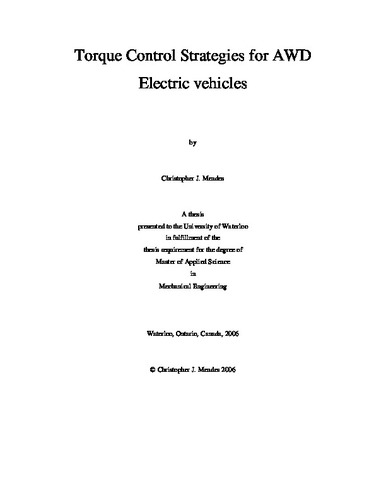| dc.contributor.author | Mendes, Chris | |
| dc.date.accessioned | 2007-02-21 20:46:03 (GMT) | |
| dc.date.available | 2007-02-21 20:46:03 (GMT) | |
| dc.date.issued | 2007-02-21T20:46:03Z | |
| dc.date.submitted | 2006 | |
| dc.identifier.uri | http://hdl.handle.net/10012/2735 | |
| dc.description.abstract | There is a fundamental shift occurring in the design of passenger vehicles for North
American markets. While for decades automotive manufacturers have relied on internal
combustion engines burning fossil fuels, the early 21st century has seen a departure from
conventional thinking about powertrain design towards two new design paradigms: hybrid
electric vehicles (HEVs), and fuel cell vehicles (FCVs).
Hybrid electric vehicles incorporate a high power electric motor and an electrical storage
system which are used for motive power in addition to their conventional internal combustion
engine (ICE). Fuel cell vehicles use a stack of individual cells to produce electric power
which is then used in an electric motor to move the vehicle. They are generally fueled by a
stream of high purity hydrogen, and produce only water as an emission. Both vehicle types
use electric motors as an integral component in their configuration.
The objective for this thesis is to propose a control strategy for the traction motors of a hybrid
or electric vehicle. In particular, it addresses the question of how to split torque between two
onboard electric motors while considering the efficiency, stability, and traction of the vehicle.
This work is based upon two hybrid vehicles: a Chevrolet Equinox converted to a Fuel Cell
HEV, and a Chrysler Pacifica converted to an internal combustion engine HEV.
A torque control strategy is recommended that focuses on improved efficiency while
addressing vehicle stability, and traction control. The strategy also incorporates powertrain
component protection. Simulations indicate that the manner in which torque is split between
the motors can have a large impact on the total efficiency of the powertrain; greater than 7%
improvement fuel economy is projected by using an intelligent torque control system over a
iii
FTP-75 drive cycle. It is recommended that this work be extended to incorporate regenerative
braking and a more thorough analysis of vehicle stability and drivability. | en |
| dc.format.extent | 2449728 bytes | |
| dc.format.mimetype | application/pdf | |
| dc.language.iso | en | en |
| dc.publisher | University of Waterloo | en |
| dc.title | Torque Control Strategies for AWD Electric Vehicles | en |
| dc.type | Master Thesis | en |
| dc.pending | false | en |
| dc.subject.program | Mechanical Engineering | en |
| uws-etd.degree.department | Mechanical and Mechatronics Engineering | en |
| uws-etd.degree | Master of Applied Science | en |
| uws.typeOfResource | Text | en |
| uws.peerReviewStatus | Unreviewed | en |
| uws.scholarLevel | Graduate | en |

